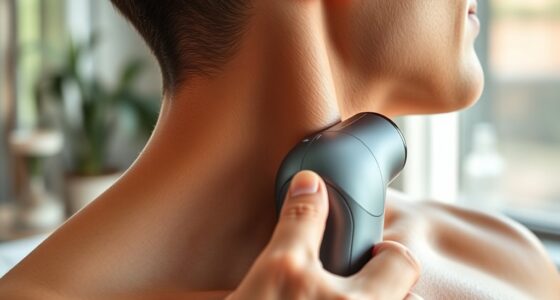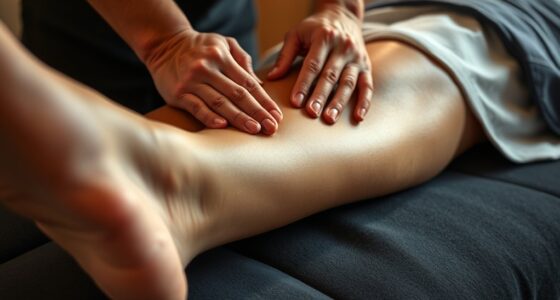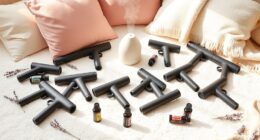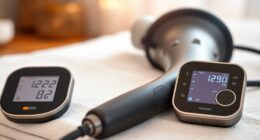Percussive therapy targets back pain naturally by delivering rapid, focused pulses to relax tight muscles, break up knots, and improve blood flow to problem areas. It helps reduce inflammation and eases discomfort by stimulating your body’s natural pain relief mechanisms. By applying the device directly to tender spots and using proper techniques, you can promote muscle relaxation and enhance recovery. Keep exploring to discover how to use this therapy effectively and safely at home.
Key Takeaways
- Percussive therapy uses rapid pulses to relax muscles and reduce soreness in back problem areas.
- It targets knots and trigger points to alleviate tension and improve blood flow.
- Deep tissue penetration helps address underlying issues causing persistent back pain.
- Regular use supports natural pain relief and enhances mobility for long-term comfort.
- Personalized treatment schedules optimize healing and prevent future discomfort.
Understanding Percussive Therapy and Its Benefits
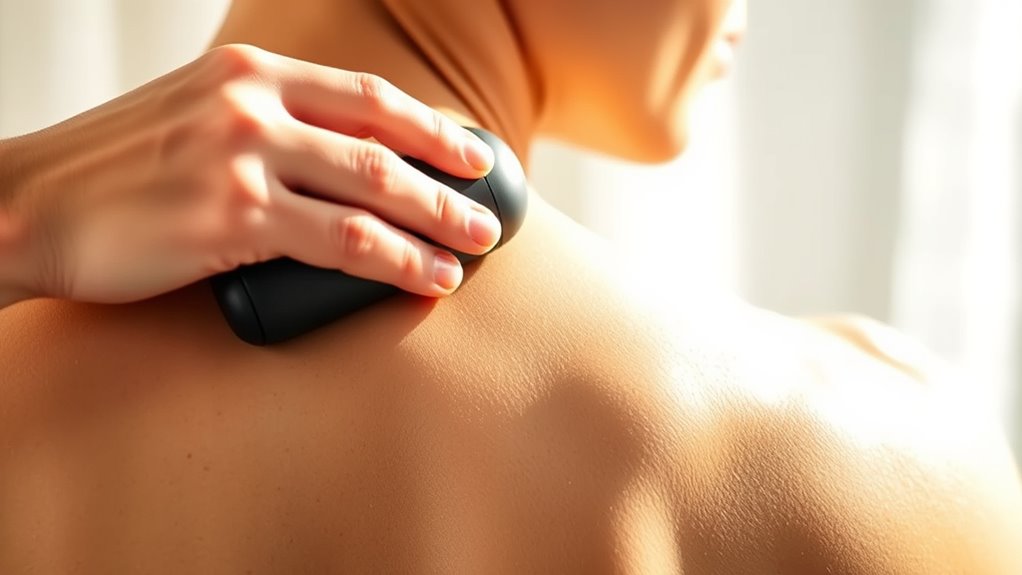
Percussive therapy is a massage technique that uses rapid, concentrated pulses to target muscle soreness and tightness. You’ll notice how these pulses stimulate blood flow, helping to promote muscle relaxation. This process not only eases tension but also contributes to pain relief by reducing inflammation and breaking up knots. As you use a percussive device, you’ll experience how it effectively targets deep muscle layers, providing immediate comfort. Many people find that regular use helps maintain flexibility and prevent future discomfort. Unlike traditional massage, percussive therapy offers a quick, focused approach to soothing sore muscles, making it easier to recover from intense activity or daily strain. Overall, it’s a powerful tool for naturally alleviating back pain and encouraging healthier muscle function. Recovery devices are designed to optimize these benefits and support your overall wellness.
Common Causes of Back Pain and How Therapy Can Help
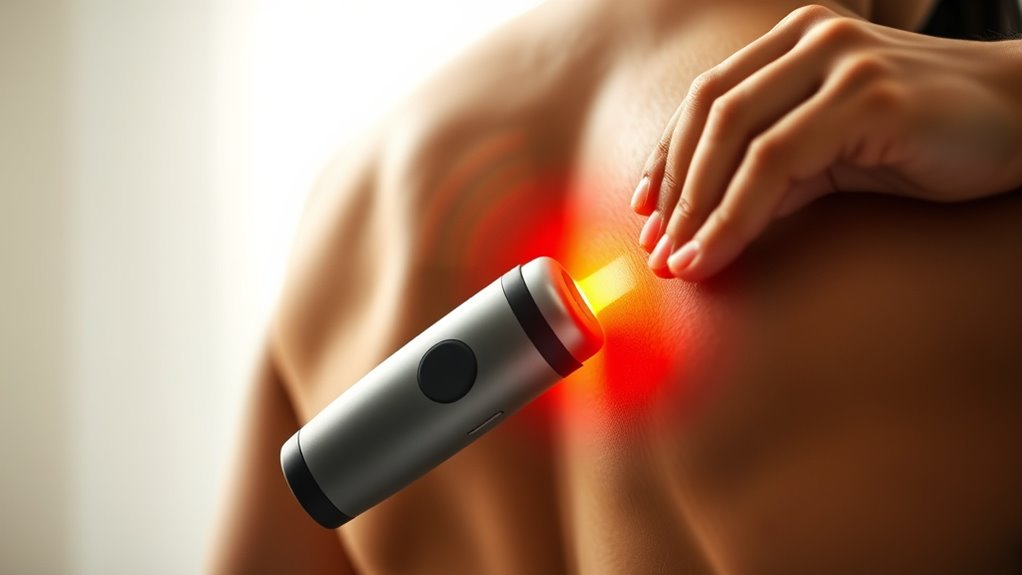
Back pain can stem from a variety of causes, including muscle strain, poor posture, and spinal issues. Muscle strain from overexertion or sudden movements often leads to discomfort, while poor posture can put extra stress on your back over time. Spinal problems such as herniated discs or misalignments also contribute substantially. Proper posture correction can prevent or reduce pain, and targeted therapy helps ease muscle strain. Addressing these causes proactively is key to relief. Incorporating percussive therapy into your routine can provide targeted relief for muscle tightness and improve blood flow.
Back pain often results from muscle strain, poor posture, and spinal issues that can be managed with proper care.
Consider these common causes:
- Muscle strain from lifting or sudden movements
- Poor posture during daily activities
- Spinal misalignments or herniated discs
- Prolonged sitting or improper ergonomics
- Lack of regular movement or exercise
How Percussive Therapy Works to Alleviate Discomfort
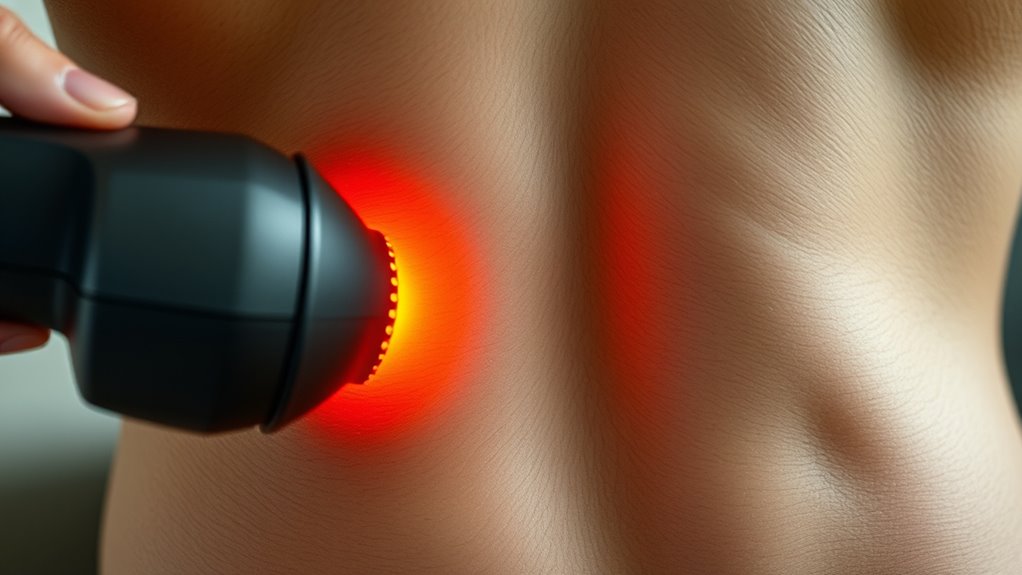
When muscles become tight or sore, percussive therapy delivers rapid, targeted pulses that disrupt pain signals and promote relaxation. This deep-tissue massage stimulates blood flow, which accelerates muscle recovery and reduces soreness. The rhythmic taps help break up knots and tightness, easing discomfort directly at the source. By activating the body’s natural pain relief mechanisms, percussive therapy provides immediate relief and encourages longer-term healing. The pulses penetrate deep into muscle tissue, helping to relax tense areas and improve overall mobility. As a result, you experience less pain and faster recovery after strenuous activity or injury. Whether used before or after exercise, this therapy supports your body’s ability to heal itself, making it an effective tool for natural back pain relief. Additionally, understanding fathers’ influence can inspire individuals to prioritize wellness and recovery as part of a healthy lifestyle.
Targeting Specific Back Areas With Percussive Devices
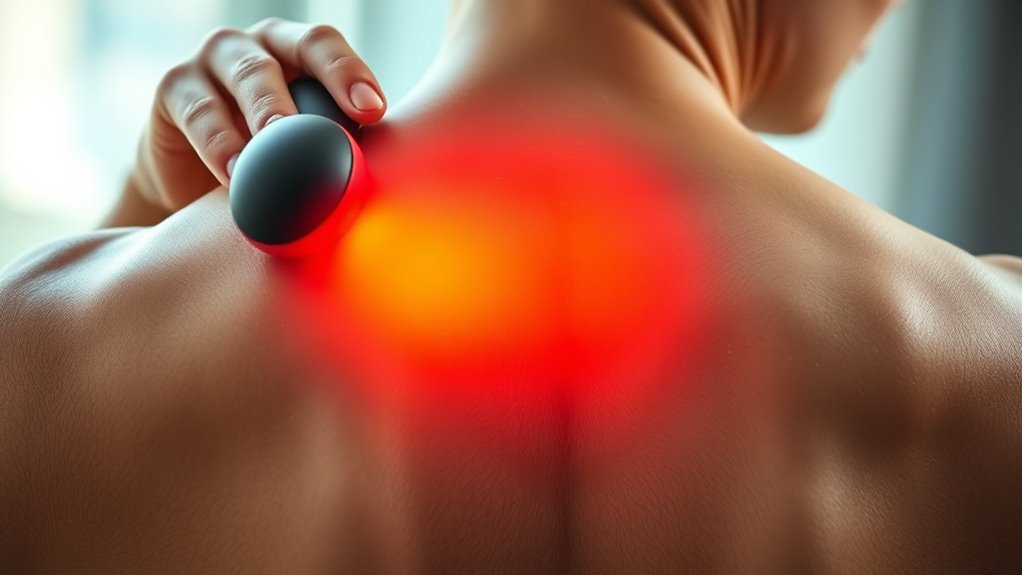
Using percussive devices effectively involves targeting specific areas of your back to maximize relief. Focus on common trouble spots like trigger points and muscle knots that cause tension and discomfort. By applying the device directly to these areas, you can release tightness and improve blood flow. Incorporating appropriate filter types can help ensure the air around you remains clean during your therapy sessions, creating a healthier environment. Consider these tips:
- Locate trigger points that feel tender or tense.
- Target muscle knots to help relax tight muscles.
- Use slow, deliberate movements for better penetration.
- Adjust pressure to avoid discomfort.
- Concentrate on areas with persistent pain or stiffness.
Focusing on these specific back areas ensures you’re addressing underlying issues rather than just symptoms, making your therapy sessions more effective. Proper targeting helps you get the most benefits from your percussive device.
Tips for Safe and Effective Use at Home

To get the best results, make sure you’re using proper technique and the right settings on your devices. Always follow safety precautions, like limiting session time and avoiding sensitive areas. Staying mindful of these tips helps you use percussive devices safely and effectively at home.
Proper Technique and Settings
Ensuring you use your pain relief devices correctly is key to maximizing their benefits and avoiding injury. Start with proper massage techniques by applying gentle pressure and maintaining consistent contact with the target area. Always check your device calibration before each use to guarantee optimal performance. Adjust the speed and intensity settings gradually to find what best relieves your pain without causing discomfort. Keep sessions short initially, then increase duration as you become comfortable. Pay attention to how your body responds and stop if you experience increased pain or discomfort. Proper technique and settings help you get the most out of percussive therapy safely. Remember, automation technologies can enable tailored and adaptive treatment approaches to enhance your pain management routine. Proper technique and settings help you get the most out of percussive therapy safely.
Precautionary Measures to Follow
Practicing precautionary measures when using pain relief devices at home helps prevent injuries and guarantees you get the most benefit from each session. Start with gentle pressure to protect your joint flexibility, especially if you have sensitive areas. Avoid overusing percussive therapy on the same spot to prevent tissue irritation. If you’re already taking pain medication, consult your doctor to ensure the therapy won’t interfere. Always follow the manufacturer’s instructions for duration and intensity, and listen to your body—discontinue use if you experience discomfort or numbness. Keep the device clean and avoid using it on swollen or inflamed areas. Incorporating AI in Business and related technologies can also assist in monitoring your treatment progress and customizing your therapy sessions for optimal safety and effectiveness. Precautionary steps like these help you safely target problem areas, maximizing relief while minimizing risk.
Incorporating Percussive Therapy Into Your Wellness Routine

Choosing the right percussive device is key to getting the most benefit without discomfort. Once you have your device, setting a consistent treatment schedule helps you stay on track and see results. Remember, tailoring these steps to your needs makes your wellness routine more effective and enjoyable. Incorporating essential oils into your routine may enhance relaxation and overall effectiveness.
Selecting the Right Device
Selecting the right device is crucial for effectively incorporating percussive therapy into your wellness routine. You want a device that matches your specific needs and preferences, so pay attention to key features. Consider device features like adjustable intensity, battery life, noise level, and size. Think about your user preferences—do you prefer lightweight, portable options or more powerful models? Look for ergonomic designs that feel comfortable during use. Additionally, check if the device offers different attachments to target various areas. Reading reviews can help you gauge durability and effectiveness. Ultimately, choosing a device aligned with your goals and comfort ensures consistent, effective relief from pain and tightness. Prioritize features that fit your lifestyle and address your specific problem areas. Incorporating personalized solutions can maximize the benefits of percussive therapy.
Establishing a Treatment Schedule
To effectively incorporate percussive therapy into your wellness routine, establishing a consistent treatment schedule is essential. Start by determining your ideal massage frequency—most people find that 3 to 5 sessions per week work well, but listen to your body. Consistency helps your muscles adapt and reduces pain over time. Keep therapy duration manageable; sessions of 10 to 15 minutes per area are usually sufficient. Avoid overdoing it, as excessive therapy can cause soreness or irritation. Track your progress and adjust your schedule as needed. Remember, the goal is to promote relaxation and healing without overstimulating your muscles. Incorporating passive voice detection tools can help you improve your writing clarity and effectiveness. By sticking to a steady routine, you’ll maximize benefits and create lasting relief from back pain.
Frequently Asked Questions
Can Percussive Therapy Replace Professional Chiropractic Treatments?
You might wonder if percussive therapy can replace chiropractic treatments. While it’s effective for relieving muscle tension and targeting problem areas, it can’t address chiropractic limitations like spinal adjustments or diagnosing underlying issues. Instead, think of percussive therapy as a helpful supplement that enhances overall pain relief. It works well alongside chiropractic care, providing therapy complementarity, but it shouldn’t replace professional treatment for extensive back health management.
Are There Any Risks or Side Effects Associated With Percussive Therapy?
You might wonder if percussive therapy is risk-free, but it does have some potential side effects. You could experience muscle soreness or even skin irritation if used improperly or on sensitive areas. While generally safe when used correctly, overuse or applying too much pressure can lead to discomfort. Always follow guidelines and consult a professional if you’re unsure, to avoid these risks and enjoy the therapy’s benefits safely.
How Often Should I Use Percussive Therapy for Back Pain?
You should follow personalized schedules and frequency guidelines based on your back pain severity and response. Typically, using percussive therapy 2-3 times a day for 1-2 minutes per area can provide relief. However, listen to your body and avoid overuse to prevent soreness. Consult a healthcare professional to tailor a routine that suits your needs, ensuring you benefit without risking irritation or injury.
Is Percussive Therapy Suitable for All Types of Back Injuries?
You might wonder if percussive therapy suits all back injuries. While it can help with muscle strain by relaxing tight muscles, it’s not ideal for nerve impingement or severe injuries. Always consult a healthcare professional before use, especially if you have nerve issues or recent trauma. Percussive therapy is most effective for muscular problems, but it’s not a one-size-fits-all solution for every back injury.
Can I Use Percussive Therapy if I Have Osteoporosis or Other Health Conditions?
Thinking of percussive therapy as a gentle rain, you might wonder if it’s safe with osteoporosis or other chronic conditions. You should always check osteoporosis precautions and consider your health history before using it. While it can help many, it’s essential to consult your healthcare provider first, especially with chronic condition considerations. This way, you protect yourself and enjoy the therapy’s benefits safely.
Conclusion
As you explore percussive therapy, you might find it’s more than just a coincidence that relief often comes when you least expect it. By targeting those stubborn problem spots, you could discover a natural way to ease back pain without relying solely on medication. Incorporating this therapy into your routine might just be the small, unexpected change that transforms your comfort and mobility, proving that sometimes, the simplest solutions are the most effective.


